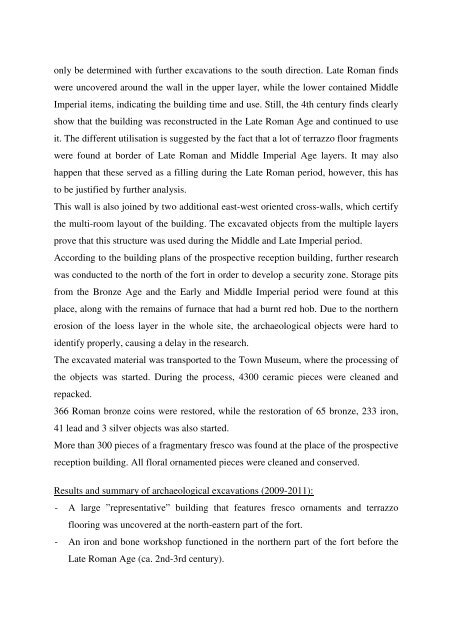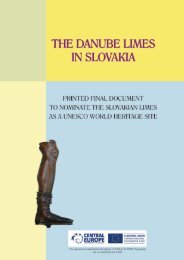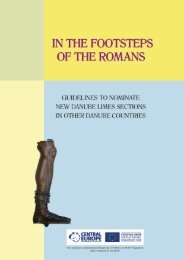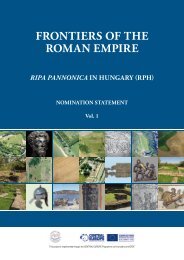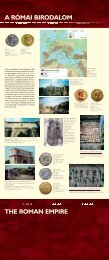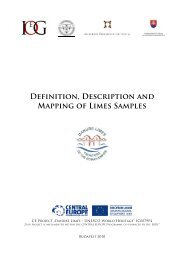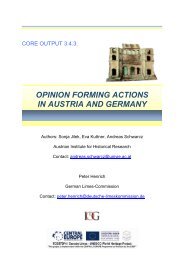Click here for the PDF version! (15,2 MB) - Danube Limes
Click here for the PDF version! (15,2 MB) - Danube Limes
Click here for the PDF version! (15,2 MB) - Danube Limes
You also want an ePaper? Increase the reach of your titles
YUMPU automatically turns print PDFs into web optimized ePapers that Google loves.
only be determined with fur<strong>the</strong>r excavations to <strong>the</strong> south direction. Late Roman finds<br />
were uncovered around <strong>the</strong> wall in <strong>the</strong> upper layer, while <strong>the</strong> lower contained Middle<br />
Imperial items, indicating <strong>the</strong> building time and use. Still, <strong>the</strong> 4th century finds clearly<br />
show that <strong>the</strong> building was reconstructed in <strong>the</strong> Late Roman Age and continued to use<br />
it. The different utilisation is suggested by <strong>the</strong> fact that a lot of terrazzo floor fragments<br />
were found at border of Late Roman and Middle Imperial Age layers. It may also<br />
happen that <strong>the</strong>se served as a filling during <strong>the</strong> Late Roman period, however, this has<br />
to be justified by fur<strong>the</strong>r analysis.<br />
This wall is also joined by two additional east-west oriented cross-walls, which certify<br />
<strong>the</strong> multi-room layout of <strong>the</strong> building. The excavated objects from <strong>the</strong> multiple layers<br />
prove that this structure was used during <strong>the</strong> Middle and Late Imperial period.<br />
According to <strong>the</strong> building plans of <strong>the</strong> prospective reception building, fur<strong>the</strong>r research<br />
was conducted to <strong>the</strong> north of <strong>the</strong> <strong>for</strong>t in order to develop a security zone. Storage pits<br />
from <strong>the</strong> Bronze Age and <strong>the</strong> Early and Middle Imperial period were found at this<br />
place, along with <strong>the</strong> remains of furnace that had a burnt red hob. Due to <strong>the</strong> nor<strong>the</strong>rn<br />
erosion of <strong>the</strong> loess layer in <strong>the</strong> whole site, <strong>the</strong> archaeological objects were hard to<br />
identify properly, causing a delay in <strong>the</strong> research.<br />
The excavated material was transported to <strong>the</strong> Town Museum, w<strong>here</strong> <strong>the</strong> processing of<br />
<strong>the</strong> objects was started. During <strong>the</strong> process, 4300 ceramic pieces were cleaned and<br />
repacked.<br />
366 Roman bronze coins were restored, while <strong>the</strong> restoration of 65 bronze, 233 iron,<br />
41 lead and 3 silver objects was also started.<br />
More than 300 pieces of a fragmentary fresco was found at <strong>the</strong> place of <strong>the</strong> prospective<br />
reception building. All floral ornamented pieces were cleaned and conserved.<br />
Results and summary of archaeological excavations (2009-2011):<br />
- A large ”representative” building that features fresco ornaments and terrazzo<br />
flooring was uncovered at <strong>the</strong> north-eastern part of <strong>the</strong> <strong>for</strong>t.<br />
- An iron and bone workshop functioned in <strong>the</strong> nor<strong>the</strong>rn part of <strong>the</strong> <strong>for</strong>t be<strong>for</strong>e <strong>the</strong><br />
Late Roman Age (ca. 2nd-3rd century).


